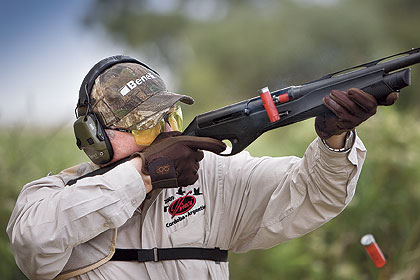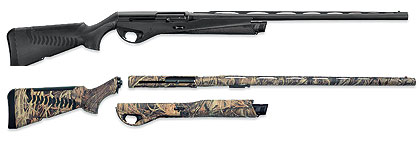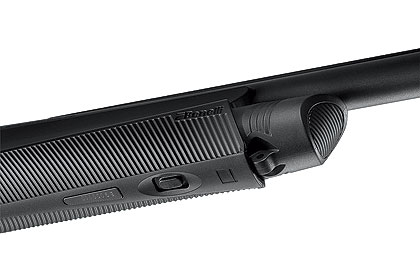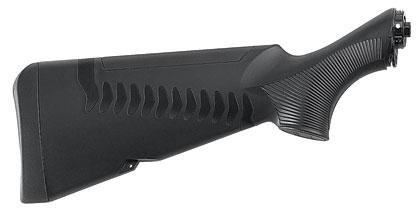By Layne Simpson
A revolutionary modular design and exceptional performance make this one a winner.For as long as autoloading shotguns have been built, the design has remained basically the same. Contained in a metal receiver is the fire-control system, the breech bolt, the ejector, and parts that cause shells to travel from a tubular magazine tube to the chamber of the barrel.
 Extremely light recoil for a 12-gauge gun along with minimal muzzle jump during firing made triples on doves entirely possible. |
The magazine is screwed into the front of the receiver and a buttstock is attached to its opposite end. The barrel slips into the front of the receiver and is held in place by the forearm, which is held in place by a cap at the end of the magazine tube. An action spring located either in the buttstock or the forearm pushes the bolt back into battery after the gun is fired.
The Benelli Vinci is like none of the above. In fact, it is like nothing you have seen before in shotguns. Of modular design, one module consists of the barrel and receiver, the two permanently joined together at the factory. This particular detail rules out the possibility of having more than one barrel for the gun, but that may be a moot point since doing so was long ago made unnecessary by the introduction of screw-in chokes.
It does eliminate the option of installing a rifled slug barrel on a bird gun, but various manufacturers tell me that few shotgun owners choose that option anyhow. Most either shoot suitable slug loads in their smoothbore barrel or they buy a dedicated shotgun with a rifled barrel, equip it with a scope, and use it exclusively for hunting deer, bear or other game.
Still, due to the rigid fit between its barrel and receiver, the Vinci should deliver excellent accuracy with slug loads such as the Remington Buckhammer and Federal's TruBall loading of the old Foster slug, both designed for use in a smoothbore barrel.
 The three modules consist of the buttstock, the barrel and receiver and the forearm assembly, the latter containing the fire-control system and the magazine tube. The Vinci is available in black and in two camouflage patterns. |
The Vinci's receiver is a simple cylinder and not much larger in diameter than the barrel. Rather than linking a return spring located in the buttstock with the bolt, Benelli engineers chose to locate the spring in the receiver where it is connected directly to the bolt.
They call it an in-line inertia system and they say it results in a noticeable reduction in both recoil and muzzle rise during firing. Many shooters don't realize that part of what they perceive as recoil is actually a blow delivered to the cheek by the stock as the shotgun recoils backward and upward. The in-line recoil of the Vinci reduces that quite dramatically.
Then we have the ComforTech Plus synthetic stock, basically a multiple-section design with the pieces connected by shock-absorbing rubber chevrons. When the gun is fired, the stock flexes and in doing so it soaks up a great deal of recoil before it reaches the shooter's shoulder.
A rubber insert in the comb of the stock increases shooter comfort even more. Add an ergonomically designed butt pad made of the same material and you have a shotgun that can be fired comfortably all day long for days on end. The Vinci is built for hunting but its soft recoil should make it a favorite of serious clay target shooters as well.
And just how comfortable is the Vinci to shoot? I used the new gun on a dove shoot in Argentina and at the end of three days my fired shell count was 6,375 rounds. I wore a thin strap-on recoil pad on my shoulder and while it always helps, it does not totally prevent bruising, even when using a 20-gauge gun.
 Twisting the end of the magazine tube counterclockwise while holding down the release button at the bottom of the forearm allows the gun to be taken down. |
As it turned out, the edge of the pad had lightly abraded my shoulder but I suffered no bruising whatsoever. My right cheek was a bit tender but otherwise I would have been good to go for another day or two of shooting.
Due to the high-volume shooting in Argentina I prefer the 20-gauge and often use the .410 and the 28-gauge. Shortly before our departure from home I was told I would be shooting a 12-gauge gun so I was not exactly looking forward to the trip. But once I had burned up a few boxes of shells with the Vinci, I realized I was shooting what may just be the most comfortable 12-gauge shotgun ever built.
The Vinci also passed the reliability test with flying colors. On the first day of the dove shoot I fired 2,200 rounds without experiencing a single malfunction. About two hours into the second day I had two failures to eject and at that point I dabbed a drop of oil to the rotating locking lugs of the bolt and applied another drop into the locking lug recesses of the barrel.
From then on I repeated the two drops of oil routine with every 50 boxes of shells and the gun never missed a lick. With the exception of the two bobbles on the second day (which were my fault) I would have gone through the entire shoot without a single malfunction.
What they claim about reduced muzzle jump seems to be equally true. Doubles proved to be easy as huge flocks of birds streamed by and as long as I kept the gun swinging smoothly, triples were not beyond the realm of possibility.
Occasionally my bird boy would shout with glee as I dropped a fourth bird before the first had hit the ground. In other words, the Vinci, along with a really good day that all shotgunners occasionally enjoy, enabled me to shoot way over my head on doves.
As all shotguns should, the Vinci comes with a stock shim kit to be used for adjusting drop and cast to the preference of the individual shooter. Recoil pads of different thicknesses that can be used to adjust length of pull are also available, and they are made for both right- and left-handed shooters. The rubber comb insert I mentioned earlier is available in different heights.
The stock and forearm have posts for the a
ttachment of a carrying sling, something deer hunters, turkey hunters and duck hunters who have to walk a long way across the marshes with a load of gear will appreciate. The modular stock design also offers the option of easily switching out one style of stock for another. An example is the so-called tactical stock with an extended grip which was developed for law enforcement use but has become popular among turkey hunters.
A lever on the right-hand side of the receiver serves two purposes. When pushed forward, it releases the bolt from its locked-back position. Pulling the lever to the rear disengages the shell latch, thereby allowing shells to be removed from the magazine without cycling them through the chamber.
 Due to spaces cut into its walls and filled with rubber chevrons, the ComforTech Plus absorbs recoil by flexing when the gun is fired. |
Beveled edges around the mouth of the loading port allow smooth insertion of shells into the magazine. Just behind the loading port, a metal indicator with red dot indicates whether or not the internal hammer is cocked. The trigger is as smooth and crisp as you will find on any autoloader and the transverse safety button is just forward of the trigger where it should be.
The new owner of a Vinci will find it easy to field-strip for cleaning. Twisting the exposed end of the magazine tube counter-clockwise while holding down its latch at the bottom of the forearm with a finger releases the forearm module from the barrel and receiver module. Since the magazine tube is not attached to the receiver, twisting it in the opposite direction releases it for removal from the forearm module.
Another twist of the wrist separates the barrel/receiver module from the buttstock. Removal of the bolt assembly and its recoil spring from the receiver are just as easily done. Taking the gun apart is quick and easy, as is putting it back together and it is easily done by someone who does not have a lot of experience with the gun.
One of my friends at Benelli will probably never forgive me for revealing this, but in a timed disassemble/reassemble race between him and a bird boy who had only the day before seen the Vinci for the first time, the bird boy won. But only by a couple of seconds, I might add.
The hammer-forged barrel of the Vinci is cryogenically treated for an extremely smooth bore surface. Barrel length options are 26 and 28 inches and both wear a steel ventilated rib with a red bar sight at the muzzle and a gold bead in the middle. Included are five screw-in chokes ranging from Cylinder to Full, all capable of handling steel shot. The gun was designed to function with all ammunition ranging from 23„4 inch target loads to the heaviest 3-inch turkey and waterfowl loads.
Everything comes in a plastic carrying case and tucked away inside with the gun and its chokes is a supply of lubricant. When we consider the half-dozen drops of lube required to keep the gun running for thousands of rounds in Argentina, it is obvious that the little bottle of oil will last a very long time. There is also a choke wrench of rather clever design -- one end can be used for removing propellant fouling and other to remove gunk from the choke threads of the barrel.
Other variations are slated for future introductions but as I write this, the Vinci is available only in 12-gauge, with a nominal weight of just under seven pounds. Finish options are black and two camouflage patterns, Mossy Oak Max-4 HD and Realtree APG.
Friends who know me well know that my taste in shotguns leans heavily toward pretty walnut and nicely blued steel. But a funny thing happened down in Argentina; the more I shot the Vinci the more I realized that beauty in a shotgun can be more than skin deep.






